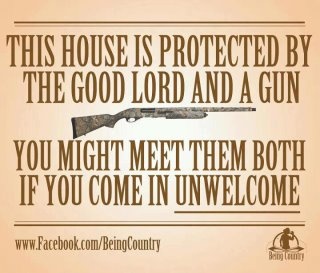
|

|
| State | % Gun Ownership | Violent Crimes/ 100,000 People |
|---|---|---|
| Alabama | 51.7 | 448 |
| Alaska | 57.8 | 661 |
| Arizona | 31.1 | 489 |
| Arkansas | 55.3 | 529 |
| California | 21.3 | 523 |
| Colorado | 34.7 | 348 |
| Connecticut | 16.7 | 256 |
| Delaware | 25.5 | 689 |
| Florida | 24.5 | 723 |
| Georgia | 40.3 | 493 |
| Hawaii | 6.7 | 273 |
| Idaho | 55.3 | 239 |
| Illinois | 20.2 | 533 |
| Indiana | 39.1 | 334 |
| Iowa | 42.9 | 295 |
| Kansas | 42.1 | 453 |
| Kentucky | 47.7 | 295 |
| Louisiana | 44.1 | 730 |
| Maine | 40.5 | 118 |
| Maryland | 21.3 | 642 |
| Massachusetts | 12.6 | 432 |
| Michigan | 38.4 | 536 |
| Minnesota | 41.7 | 289 |
| Mississippi | 55.3 | 291 |
| Missouri | 41.7 | 505 |
| Montana | 57.7 | 288 |
| Nebraska | 38.6 | 302 |
| Nevada | 33.8 | 751 |
| New Hampshire | 30.0 | 137 |
| New Jersey | 12.3 | 329 |
| New Mexico | 34.8 | 664 |
| New York | 18.0 | 414 |
| North Carolina | 41.3 | 466 |
| North Dakota | 50.7 | 142 |
| Ohio | 32.4 | 343 |
| Oklahoma | 42.9 | 500 |
| Oregon | 39.8 | 288 |
| Pennsylvania | 34.7 | 417 |
| Rhode Island | 12.8 | 227 |
| South Carolina | 42.3 | 788 |
| South Dakota | 56.6 | 169 |
| Tennessee | 43.9 | 753 |
| Texas | 35.9 | 511 |
| Utah | 43.9 | 235 |
| Vermont | 42.0 | 124 |
| Virginia | 35.1 | 270 |
| Washington | 33.1 | 333 |
| West Virginia | 55.4 | 275 |
| Wisconsin | 44.4 | 291 |
| Wyoming | 59.7 | 239 |
If we sort by percentage of gun ownership, a pattern begins to emerge.
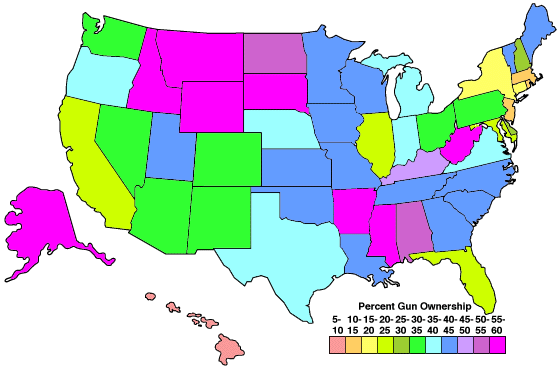
A frequent claim of those opposed to gun ownership is that the crime rate is a function of the percentage of gun owners. The following graph shows no significant correlation.
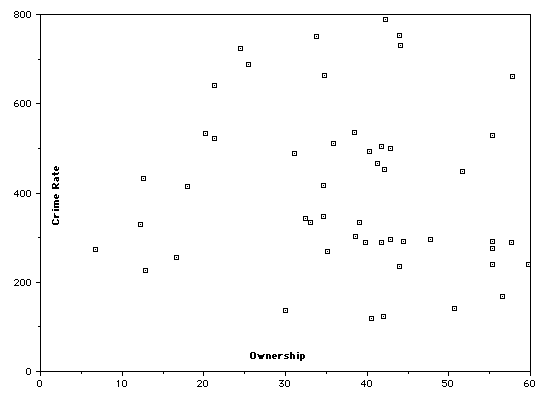
I began wondering if there was some metric that could be used to determine the degree of protection each state had by being able to defend themselves against violent crimes (murder, forcable rape, robbery, aggrevated assault). I came up with the Protection Quotient (PQ), the degree of protection each citizen has against the rate of violent crime by owning a firearm. A PQ twice as high indicates double the percentage of gun ownership for the same crime rate, or half the crime rate for the same percentage of ownership. It varies between 357 for North Dakota, with over 50% gun ownership and a fairly low crime rate, and Hawaii, with almost twice the crime rate and the lowest gun ownership by far of any state. This is how it breaks out overall:
| State | % Gun Ownership | Violent Crimes/ 100,000 People | Protection quotient |
|---|---|---|---|
| North Dakota | 50.7 | 142 | 357 |
| Maine | 40.5 | 118 | 343 |
| Vermont | 42.0 | 124 | 339 |
| South Dakota | 56.6 | 169 | 335 |
| Wyoming | 59.7 | 239 | 250 |
| Idaho | 55.3 | 239 | 231 |
| New Hampshire | 30.0 | 137 | 219 |
| West Virginia | 55.4 | 275 | 201 |
| Montana | 57.7 | 288 | 200 |
| Mississippi | 55.3 | 291 | 190 |
| Utah | 43.9 | 235 | 187 |
| Kentucky | 47.7 | 295 | 162 |
| Wisconsin | 44.4 | 291 | 152 |
| Iowa | 42.9 | 295 | 145 |
| Minnesota | 41.7 | 289 | 144 |
| Oregon | 39.8 | 288 | 138 |
| Virginia | 35.1 | 270 | 130 |
| Nebraska | 38.6 | 302 | 128 |
| Indiana | 39.1 | 334 | 117 |
| Alabama | 51.7 | 448 | 115 |
| Arkansas | 55.3 | 529 | 105 |
| Colorado | 34.7 | 348 | 100 |
| Washington | 33.1 | 333 | 99 |
| Ohio | 32.4 | 343 | 94 |
| Kansas | 42.1 | 453 | 93 |
| North Carolina | 41.3 | 466 | 89 |
| Alaska | 57.8 | 661 | 87 |
| Oklahoma | 42.9 | 500 | 86 |
| Missouri | 41.7 | 505 | 83 |
| Pennsylvania | 34.7 | 417 | 83 |
| Georgia | 40.3 | 493 | 82 |
| Michigan | 38.4 | 536 | 72 |
| Texas | 35.9 | 511 | 70 |
| Connecticut | 16.7 | 256 | 65 |
| Arizona | 31.1 | 489 | 64 |
| Louisiana | 44.1 | 730 | 60 |
| Tennessee | 43.9 | 753 | 58 |
| Rhode Island | 12.8 | 227 | 56 |
| South Carolina | 42.3 | 788 | 54 |
| New Mexico | 34.8 | 664 | 52 |
| Nevada | 33.8 | 751 | 45 |
| New York | 18.0 | 414 | 43 |
| California | 21.3 | 523 | 41 |
| Illinois | 20.2 | 533 | 38 |
| Delaware | 25.5 | 689 | 37 |
| New Jersey | 12.3 | 329 | 37 |
| Florida | 24.5 | 723 | 34 |
| Maryland | 21.3 | 642 | 33 |
| Massachusetts | 12.6 | 432 | 29 |
| Hawaii | 6.7 | 273 | 25 |
If we compare the crime rate as a function of the protection quotient, we can see that the states in which the people are better protected generally have a lower crime rate. This is basically the idea of the protection quotient.
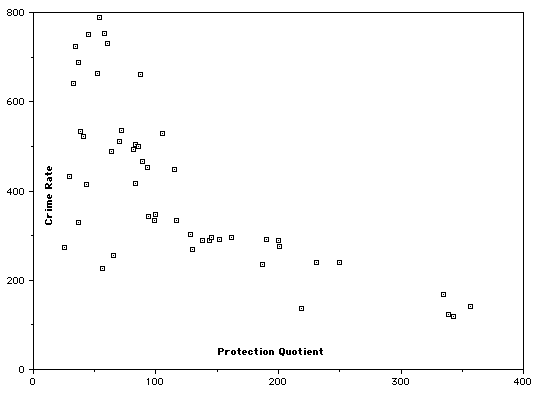
Finally, not surprisingly, the protection quotient is higher in states in which there is a higher percentage of gun ownership. This is made more obvious by adjusting for the crime rate.
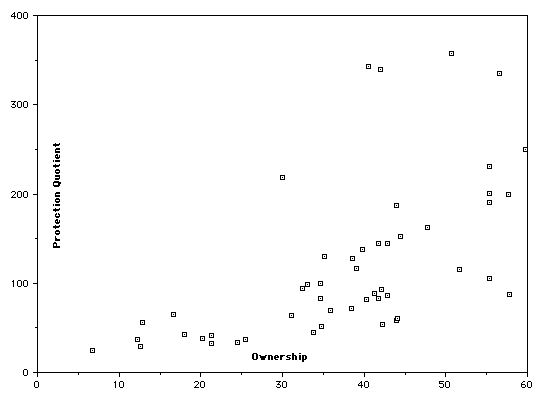
What do you think?
John Lindorfer